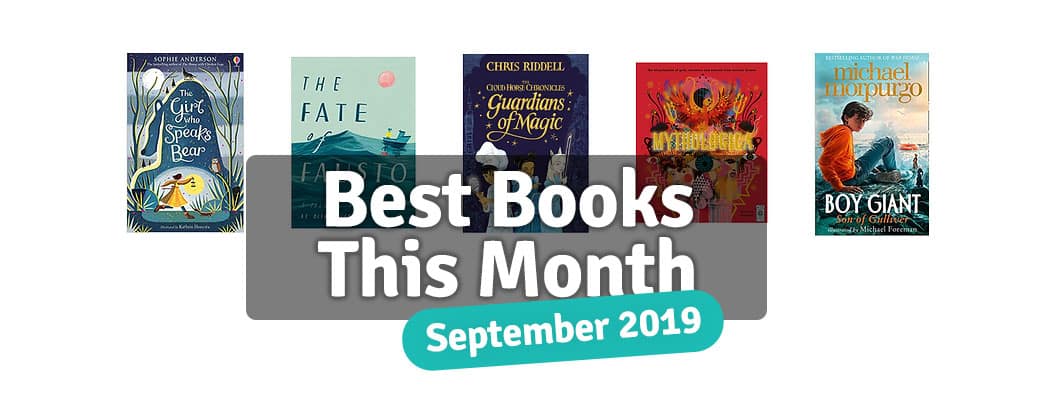It’s easy to feel lost in the flood of so many new children’s books available. Each month, we pick five of our recently published favourites.
Check out our Review Panel’s top picks for you to read in September 2019…


It’s easy to feel lost in the flood of so many new children’s books available. Each month, we pick five of our recently published favourites.
Check out our Review Panel’s top picks for you to read in September 2019…
Fans of The House with Chicken Legs will be delighted to see a new middle-grade offering from Sophie Anderson and this new book is also a thoroughly modern story woven from a tapestry of traditional Russian folktales.
Yanka is a 12-year-old girl who has never found out where she really belongs. Standing out from the crowd by being much taller than the other children in her village and as strong as a bear, Yanka’s sense of displacement is deepened by the fact that she was abandoned in a bear cave as a baby and knows nothing about her real parents. She has always felt a strange pull towards the nearby forest and delights in hearing magical tales about the creatures within.
One day, Yanka wakes up to find that her legs have become bear legs. Horrified, she clumsily hot-foots into the forest and begins an epic quest to discover who she really is. The journey takes Yanka from ice-cold rivers to fiery volcanoes as she meets a mélange of magical characters along the way (including – much to my delight – the appearance of a house with chicken legs who helps out along the way…). As Yanka’s journey to discover more about her identity unfolds, the plot is interwoven with traditional folktales about bears, dragons and wish-granting trees, each one cleverly offering important clues to piece together about Yanka’s origins.
There is so much to love about Anderson’s storytelling. The stories-within-a-story feel like a beautifully crafted pass-the-parcel with delights to unwrap in each layer. The author’s appreciation of the natural world radiates through as the reader experiences the full sensory delights of the forest through Yanka, from the sensation of rolling in fresh pine needles to the realisation that every tree has its own unique scent. The familiar aspects of the forest seamlessly blend with the more fantastical ones, like the ancient tree that grants wishes or the fire-breathing dragon called Smey.
I highly recommend The Girl Who Speaks Bear to upper KS2 for its rich storytelling, its relatable themes and its wonderfully imaginative fantasy worlds.
Award-winning picture book creator Oliver Jeffers brings us a modern day ‘painted fable’ about one man’s greedy desire to possess everything. Readers familiar with Jeffers’ books will know to expect colourful, exquisite illustrations and poignant text and this book continues to be marked by the same distinctive style but has a much more minimalistic feel, with sparse text and expenses of white pages demanding of the reader moments to pause and think about the story’s important message.
The central character Fausto is greedy, tyrannical and self-important as he strolls through the landscape, surveying what he sees and declaring that it all belongs to him. “You are mine,” he tells the flower, a sheep, a tree and a lake. With little resistance his new subjects agree to be his, but Fausto finds the mountain less yielding. Fausto stamps his feet in rage and puts up a fight until the mountain bows down to him and agrees to be owned. Looking for something larger to conquer, Fausto turns to the vast blue sea, but his happy tyranny soon turns to ‘anger and importance’ as the sea is altogether more resistant. Resorting once more to foot-stamping, Fausto (unable to swim) is quickly swallowed up by the sea’s depths and the natural world returns to its original serenity. The narrative ends showing the natural elements at peace and by reminding the reader that ‘The Fate of Fausto did not matter to them.’
Minimal text and suggestive illustrations work together beautifully, allowing the reader to fill the gaps. With such an important message about human greed and the destructive nature of materialism, the book refuses to allow the reader to sit back without engaging with the point that sometimes, in the grand scheme of things, less is more.
Jeffers uses traditional lithographic printmaking techniques to create the illustrations, setting neon pinks and yellows against earthier shades of greens, browns and blues. Fausto’s body language brilliantly captures his pomposity and aggression, with toddler-like poses and scribbles of rage contrasting with the controlled, textured strokes of the landscape.
There’s something for young and old in this unusual and thought-provoking tale; humour, warmth and the hint of discomfort that arrives when we recognise aspects of our own attitudes in Fausto’s fable and hope for a better fate for ourselves.
The Cloud Horse Chronicles is a new fantasy series by much-loved author-illustrator Chris Riddell.
The first in the series, Guardians of Magic, sets the scene and follows the adventures of Zam, Phoebe and Bathsheba, three children who come across bespoke gifts crafted from the magical wood of the Forever Tree. Each of the three children belongs to a different town within the kingdom of Thrynne, which is brilliantly brought to life throughout the book with Chris Riddell’s incredibly detailed sketches and illustrated maps.
Magic is under threat in the kingdom of Thrynne and anybody tapping into the ancient magic of the Forever Tree is immediately in danger. Powerful villains keep magic at bay in each town in order to pursue their own selfish agendas. A king rat called Tiberius-Tiberius terrorises Zam’s home of Troutwine. A power-hungry Clockmaker with an army of mechanical tin-men rules Phoebe’s town of Nightingale. Euphemia Goldencurls, a professional Princess wishing to keep alive the lucrative business of slaying giants, manipulates the townsfolk of Bathsheba’s tree-house town of Beam. In between the three towns stands the Great Wood – said to be full of fantastical forest creatures – and the boulder-filled landscape of the Tumbledowns, which is home to creatures who are outcasts and misfits.
Destined to fight back and keep the Forever Tree’s magic alive, the three children leave their homes and, armed with their magical objects (a runcible spoon that creates living gingerbread creatures, a cello that speaks and dreams and a glowing worpel sword), they come together to fight the villains who wrongly threaten the tree’s sacred magic for their own dark desires. With help from the beautiful cloud horses, who live in the forever tree and grant wishes, the children evade danger and use their courage and wit to embark upon a unique magical quest.
The generous illustrations make this middle-grade fantasy really special, with character sketches, maps and building cross-sections that both delight and inform. Riddell’s distinctive pencil-sketch style provides spectacular detail that gives his magical world credibility and layers of interest. Dotted throughout the story’s narrative and pictures are familiar story characters – the Pied Piper, Puss-in-Boots, porridge-loving bears, an Owl-and-Pussycat duo and an old woman who lives in a shoe casually cameo alongside a cast of more original magical folk. The show-stopping page is a full-colour illustration of the towering giant Olaf Cloudscapper, which folds out to impress the sense of his enormity compared to the human characters.
Guardians of Magic is an enjoyable start to what promises to be a brilliant fantasy series and I am looking forward to seeing how the stories build in the next instalments.
Impressive from the outset, this large-format, boldly-stylized hardback book is a visual feast exploring the details of 50 Greek gods, goddesses, mortals and monsters. Each spread shows a new character, with poster-like images depicting the classical characters in a new light; vibrant, modern representations in an energetically layered collage style. Classics scholar Dr Stephen Kershaw provides a written description of each of the 50 characters, bringing out key characteristics, roles and relationships as well as a summary of the associated myths. Suitable for upper KS2+.
Award-winning storyteller Sir Michael Morpurgo brings his loyal readership a brand new novel this autumn, brought to life with line illustrations by Michael Foreman.
Boy Giant: Son of Gulliver is a heartwarming refugee story about hope and humanity in times of being without a place to call home. Omar is making the perilous journey across the sea to England after his home in Afghanistan has been devastated by war. After seeing his family torn apart, Omar and his mother walk for miles to reach the coastline in order to board a boat heading to a safer place to find refuge. Not having enough money to pay the fare for two, Mother persuades Omar to take the journey to England alone and wait for her there. Uncle Said owns a cafe on Fore Street, Mevagissey and Omar repeats the address over and over so that he doesn’t forget where to wait.
The sea journey is terrifyingly perilous and before long waves are crashing over the sides and Omar watches the boat fill with water as hope of being reunited with mother begins to fade. A powerful sea storm sees Omar losing consciousness and after a while he awakes on the shores of an island. Taking in the crowd of friendly and curious faces staring at him and hearing a few words that he recognises from his limited English, Omar dares to hope that he has reached England’s shores at last. There’s only one problem; the people here are small enough to fit in his hand and he is a mountainous giant by comparison. Omar soon realises much to his dismay that this is not England but the island of Lilliput, which keen-eyed readers may recognise from the story of Gulliver’s Travels set a few hundred years before. Now, the Lilliputians call Omar a ‘Son of Gulliver’ and welcome him with warmth and kindness. But Omar soon discovers that the island is under threat, and the peace-making legacy of Gulliver from the past needs his help to be restored.
This is a gripping story offering an original twist on a well-loved classic. The story of Gulliver is cleverly leaned upon in both structure and narrative and the revisiting of Lilliput is delightful to those familiar with the details and themes of Gulliver’s Travels. Importantly, it does not matter that the majority of young readers will be unfamiliar with the original, as Morpurgo explains all the necessary background through the story.
With important themes of reconciliation, kindness to strangers and the devastating effects of war, this is a thrilling read that raises questions about whether humanity will ever learn from its past as well as being an imaginatively-rendered encouragement to individuals to seek reconciliation over conflict in everyday situations.


© BooksForTopics 2015-2024
review
Year group(s) the book is most suitable for:
Year group(s) the book is most suitable for:
Does the book contain anything that teachers would wish to know about before recommending in class (strong language, sensitive topics etc.)?
Does the book contain anything that teachers would wish to know about before recommending in class (strong language, sensitive topics etc.)?
Would you recommend the book for use in primary schools?
yes
Curriculum links (if relevant)
Curriculum links (if relevant)
Any other comments
Any other comments